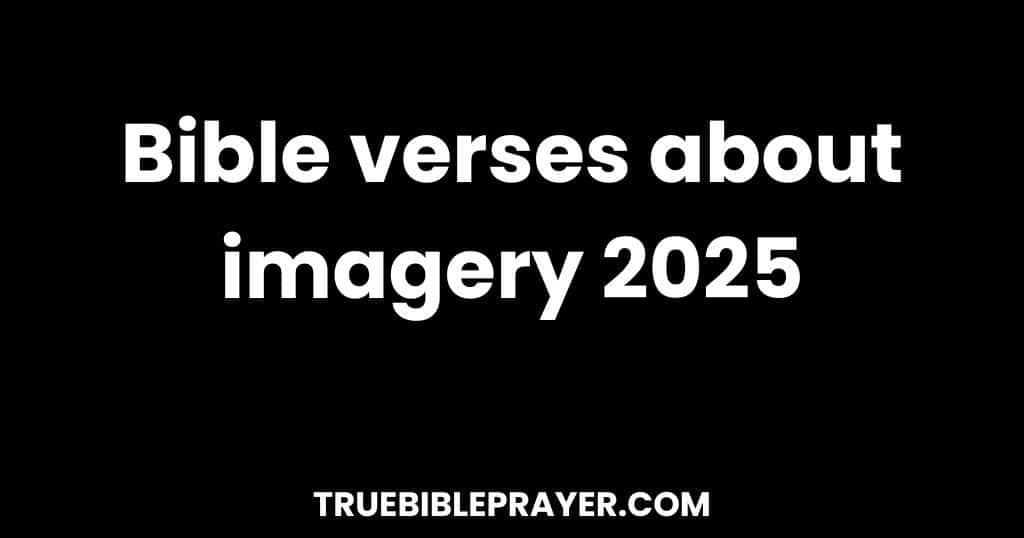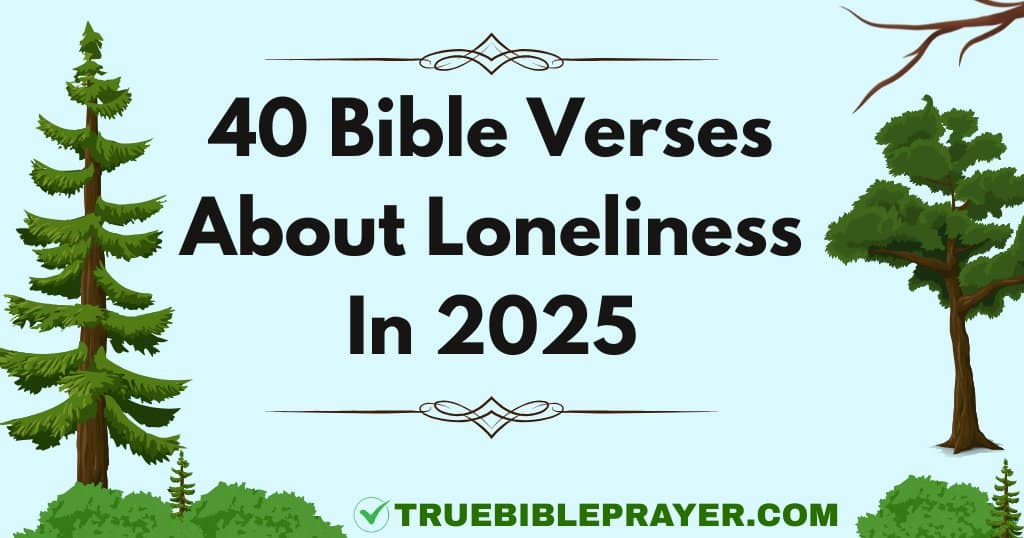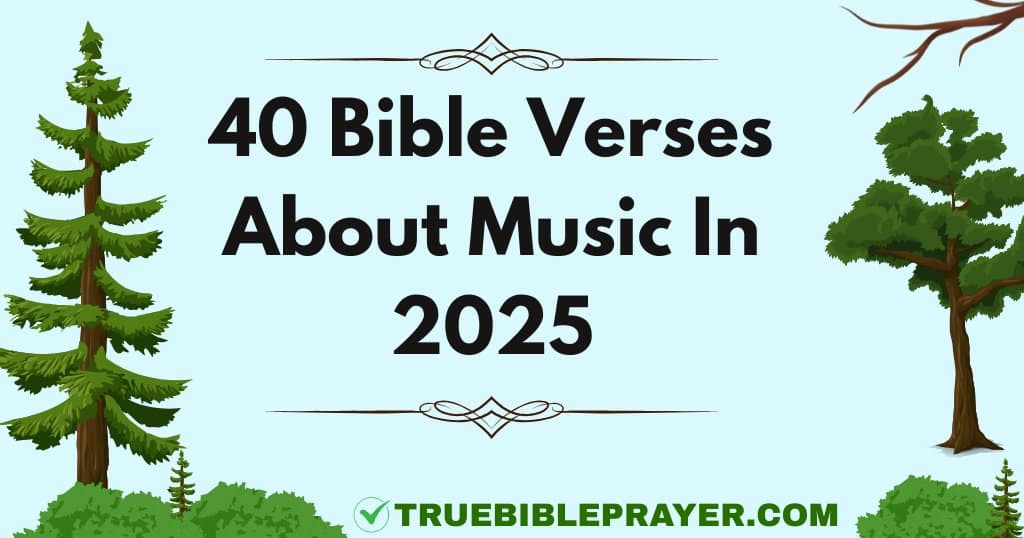Imagery is the use of vivid and descriptive language or visual elements that help create mental pictures, emotions, or deeper meaning. In a biblical context, imagery often appears through symbolic language, visions, parables, or artwork that represents spiritual truths.
You will explore powerful Bible verses that use rich language to reveal truth and stir faith. Each verse comes with clear meaning and insight to help you understand, reflect, and apply what you read.
What does the Bible say about imagery?
The Bible uses imagery to reveal deep spiritual truth. Visions, symbols, and parables help the heart grasp what words alone cannot. God often speaks through pictures that stir faith and awaken understanding. These images carry meaning, not just beauty.
But the Bible also warns against false or misleading images. God forbids using carved idols in worship because they distort His nature. Imagery should reflect truth, not replace it. When used with reverence, it points us closer to Him—not away.
Symbolic and Visionary Imagery in Scripture
Psalm 119:105
“Your word is a lamp to my feet and a light to my path.”
Description: This verse uses visual imagery to describe how God’s Word brings direction and clarity.
Interpretation: Scripture is pictured as light, guiding believers through darkness and uncertainty. It shows how imagery helps express the unseen work of divine truth.
Psalm 1:3
“He is like a tree planted by streams of water that yields its fruit in its season, and its leaf does not wither.”
Description: A righteous person is compared to a fruitful tree in a life-giving environment.
Interpretation: This natural image illustrates how staying rooted in God’s Word produces steady growth and spiritual strength. Imagery connects behavior to outcome.
Psalm 23:1–2
“The Lord is my shepherd; I shall not want. He makes me lie down in green pastures.”
Description: The Lord is portrayed as a shepherd leading His sheep to peace and provision.
Interpretation: This poetic image expresses care, protection, and rest. Imagery here comforts the soul with a visual of divine leadership.
Revelation 1:12
“Then I turned to see the voice that was speaking to me, and on turning I saw seven golden lampstands.”
Description: John sees a symbolic vision while receiving a message from Christ.
Interpretation: The lampstands represent churches. Biblical imagery often uses physical objects to symbolize spiritual realities that affect believers.
Revelation 1:14
“His head and hair were white like wool, as white as snow, and His eyes like a flame of fire.”
Description: Jesus is described in a glorified and symbolic form in this vision.
Interpretation: Imagery reveals His purity, wisdom, and penetrating judgment. The symbolism stirs reverence and awe in the reader.
Revelation 6:8
“And I looked, and behold, a pale horse, and its rider’s name was Death, and Hades followed him.”
Description: One of the Four Horsemen appears in a dramatic, prophetic vision.
Interpretation: The pale horse image conveys judgment, mortality, and the power of divine prophecy. This vision uses imagery to warn and prepare.
Proverbs 18:10
“The name of the Lord is a strong tower; the righteous man runs into it and is safe.”
Description: God’s protection is compared to a fortified tower in battle.
Interpretation: This metaphor gives visual comfort to those who trust in God. Imagery here symbolizes safety through faith in His power.
Colossians 1:15
“He is the image of the invisible God, the firstborn of all creation.”
Description: Paul speaks of Christ’s divine nature using the word “image.”
Interpretation: Jesus is the visible expression of the unseen God. This verse links divine imagery with the person of Christ, showing its holy purpose.
Deuteronomy 4:24
“For the Lord your God is a consuming fire, a jealous God.”
Description: God is described through powerful natural imagery.
Interpretation: Fire expresses both His holiness and His passionate protection of His people. This type of imagery stirs healthy fear and respect.
Revelation 1:16
“Out of his mouth came a sharp two-edged sword, and his face was like the sun shining in full strength.”
Description: Another vision of Christ filled with intense visual symbols.
Interpretation: The sword represents His Word, and the sun reveals His glory. This verse uses layered imagery to reveal both power and authority.
Warnings Against Idolatrous Imagery
Exodus 20:4
“You shall not make for yourself a carved image, or any likeness of anything that is in heaven above, or that is on the earth beneath, or that is in the water under the earth.”
Description: This is part of the Ten Commandments and sets a clear boundary.
Interpretation: God forbids creating physical images for worship. This protects believers from reducing His glory to man-made forms, a key issue in biblical imagery.
Psalm 115:4
“Their idols are silver and gold, the work of human hands.”
Description: The psalmist describes false gods made from precious metals.
Interpretation: This verse highlights the emptiness of man-made imagery when used to represent divine power. It criticizes worship built on physical objects.
Psalm 115:5
“They have mouths, but do not speak; eyes, but do not see.”
Description: The psalm continues by exposing the lifeless nature of idols.
Interpretation: These words confront the illusion of power in images. Imagery without truth misleads and cannot respond to human need.
Exodus 20:5
“You shall not bow down to them or serve them, for I the Lord your God am a jealous God.”
Description: A direct command not only against creating images but also against honoring them.
Interpretation: God’s jealousy is protective. He demands that worship remain spiritual and relational, not reduced to physical forms.
Deuteronomy 4:23
“Take care, lest you forget the covenant of the Lord your God, which he made with you, and make a carved image.”
Description: Moses warns Israel against drifting into idol-making.
Interpretation: The danger of imagery lies in its potential to replace a living relationship with God. The verse calls for deep spiritual loyalty.
Psalm 115:8
“Those who make them become like them; so do all who trust in them.”
Description: A sharp warning about the influence of idolatrous imagery.
Interpretation: This verse shows that worshiping lifeless images shapes the worshiper. The result is spiritual deadness rather than divine connection.
1 John 5:21
“Little children, keep yourselves from idols.”
Description: A short but urgent command from the New Testament.
Interpretation: John calls for vigilance. Even in modern times, the heart can turn images, desires, or symbols into idols. The warning remains clear.
Romans 1:25
“They exchanged the truth about God for a lie and worshiped and served the creature rather than the Creator.”
Description: Paul exposes how people distort truth through created things.
Interpretation: This verse addresses how imagery becomes dangerous when it reflects human fantasy rather than divine reality. Truth must lead worship.
Leviticus 19:4
“Do not turn to idols or make for yourselves any gods of cast metal: I am the Lord your God.”
Description: This law separates holy worship from cultural practices of image-making.
Interpretation: God claims exclusive devotion. The verse challenges any use of imagery that competes with His presence and truth.
Psalm 106:19
“They made a calf in Horeb and worshiped a metal image.”
Description: A reference to Israel’s sin with the golden calf.
Interpretation: Even after witnessing God’s power, people turned to an image they could see. This moment reveals how easily visual symbols can mislead if not grounded in faith.
Artistic Imagery for Worship and Glory
Exodus 26:31
“You shall make a veil of blue and purple and scarlet yarns and fine twined linen. It shall be made with cherubim skillfully worked into it.”
Description: God gives Moses instructions for the tabernacle’s sacred veil.
Interpretation: Artistic imagery was commanded by God to symbolize holiness and the heavenly realm. Here, images were crafted to reflect awe, not control.
Exodus 35:30–31
“Then Moses said to the people of Israel, ‘See, the Lord has called by name Bezalel… and he has filled him with the Spirit of God, with skill, with intelligence, with knowledge, and with all craftsmanship.’”
Description: God empowered artists for the work of worship.
Interpretation: Imagery and creativity are seen as spiritual gifts when used for God’s purposes. This verse affirms that sacred art can honor God’s presence.
Exodus 35:35
“He has filled them with skill to do every sort of work done by an engraver or by a designer or by an embroiderer.”
Description: God’s Spirit gave wisdom for detailed design.
Interpretation: Imagery crafted with purpose and devotion was part of divine worship. The beauty was not for human praise, but to reflect God’s excellence.
Exodus 25:18
“And you shall make two cherubim of gold; of hammered work shall you make them, on the two ends of the mercy seat.”
Description: Visual symbols were placed at the very center of the tabernacle.
Interpretation: The cherubim did not replace God but pointed to His holiness. This shows the difference between honoring God’s presence and misusing images.
Ephesians 2:10
“For we are his workmanship, created in Christ Jesus for good works, which God prepared beforehand, that we should walk in them.”
Description: Paul describes believers as God’s creation.
Interpretation: This verse uses imagery to express purpose and beauty in life. Believers reflect divine design, much like sacred art reflects the Creator.
1 Kings 6:29
“He carved all the walls of the house round about with carved figures of cherubim and palm trees and open flowers, in the inner and outer rooms.”
Description: Solomon adorned the temple with detailed artistic images.
Interpretation: These visual elements honored God’s creation. The use of nature and heavenly beings in imagery helped direct attention upward, not inward.
1 Kings 6:21
“So Solomon overlaid the house inside with pure gold. And he drew chains of gold across, in front of the inner sanctuary, and overlaid it with gold.”
Description: The temple was filled with precious materials and sacred imagery.
Interpretation: Artistic detail showed God’s worthiness. Imagery used this way reminded worshipers of God’s majesty and holiness.
Exodus 28:33
“Make pomegranates of blue, purple and scarlet yarn around the hem of the robe, with gold bells between them.”
Description: God gave instructions for the priestly garments.
Interpretation: Even clothing carried symbolic imagery. Pomegranates signified fruitfulness, while bells reflected purity and attention to God’s presence.
Exodus 25:40
“See that you make them after the pattern for them, which is being shown you on the mountain.”
Description: God showed Moses a heavenly pattern for the tabernacle’s design.
Interpretation: Imagery in worship was not random but revealed by God. This ensured that sacred images aligned with heavenly truth, not human invention.
Psalm 33:3
“Sing to him a new song; play skillfully on the strings, with loud shouts.”
Description: The psalm calls for excellence in creative worship.
Interpretation: Just as sound can be artistic, so can visual expression. Skill and beauty in worship are encouraged when used to glorify God sincerely.
Divine Imagery and Revelation
John 1:14
“And the Word became flesh and dwelt among us, and we have seen his glory, glory as of the only Son from the Father, full of grace and truth.”
Description: John describes Jesus as the living image of God’s Word.
Interpretation: Divine truth took on visible form in Christ. This verse ties imagery to incarnation—where the unseen became real for human eyes.
1 Corinthians 13:12
“For now we see in a mirror dimly, but then face to face. Now I know in part; then I shall know fully, even as I have been fully known.”
Description: Paul reflects on the limited clarity we have in this life.
Interpretation: Imagery serves as a temporary glimpse of eternal truth. One day, the veil will lift, and every symbol will be fulfilled in direct experience.
John 1:18
“No one has ever seen God; the only God, who is at the Father’s side, he has made him known.”
Description: Christ reveals what cannot be seen by natural eyes.
Interpretation: Divine imagery must be God-given. This verse reminds us that spiritual insight comes through revelation, not imagination.
John 14:9
“Whoever has seen me has seen the Father. How can you say, ‘Show us the Father’?”
Description: Jesus responds to Philip’s request for a visible image of God.
Interpretation: Christ is the perfect expression of divine character. In Him, spiritual truth took physical form without distortion.
Isaiah 33:17
“Your eyes will behold the king in his beauty; they will see a land that stretches afar.”
Description: Isaiah promises a future vision of divine majesty.
Interpretation: Imagery of kingship and landscape speaks of eternal hope. The beauty of the King inspires faith and longing for God’s kingdom.
Isaiah 6:1
“In the year that King Uzziah died I saw the Lord sitting upon a throne, high and lifted up; and the train of his robe filled the temple.”
Description: Isaiah receives a heavenly vision that shakes him.
Interpretation: The throne, the robe, the glory—every image reveals divine holiness. This moment proves how imagery can lead to deep conviction and awe.
Genesis 28:12
“And he dreamed, and behold, there was a ladder set up on the earth, and the top of it reached to heaven. And behold, the angels of God were ascending and descending on it!”
Description: Jacob’s dream connects heaven and earth.
Interpretation: This image shows God’s activity and presence across realms. Dreams and symbols in Scripture often serve as bridges to spiritual truth.
Revelation 4:1
“After this I looked, and behold, a door standing open in heaven! And the first voice, which I had heard speaking to me like a trumpet, said, ‘Come up here.’”
Description: John sees an open door to heavenly revelation.
Interpretation: Imagery gives access to what is unseen. This verse shows how visions pull back the curtain on eternity, inviting us into divine understanding.
Revelation 21:1
“Then I saw a new heaven and a new earth, for the first heaven and the first earth had passed away.”
Description: John witnesses the beginning of God’s final renewal.
Interpretation: This image expresses total transformation. Biblical imagery often points beyond destruction to restoration and eternal beauty.
Revelation 22:4
“They will see his face, and his name will be on their foreheads.”
Description: The promise of direct, eternal communion with God.
Interpretation: In the end, no symbol is needed—only presence. But until then, imagery carries us forward in hope, faith, and anticipation.
Conclusion
The Bible uses imagery to teach, warn, and reveal deep spiritual truths. You have seen how Scripture paints clear pictures through visions, symbols, and sacred design. At the same time, it warns against using images in ways that distract from true worship or mislead the heart.
This journey through forty verses has shown the difference between holy imagery and harmful idols. You now understand how God uses visual language to reach the soul and how believers must handle it with care, reverence, and truth.
What you learned is not just knowledge. It brings clarity to your questions and peace to your search. Keep your eyes fixed on what is true, and let the imagery of Scripture shape your faith, not your fears.




